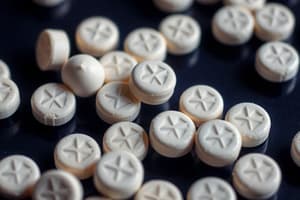Podcast
Questions and Answers
Amino acids have been demonstrated to increase the risk of toxicity in treatment.
Amino acids have been demonstrated to increase the risk of toxicity in treatment.
False (B)
Botulinum toxin is now considered the preferred treatment for disabling localized dyskinesia.
Botulinum toxin is now considered the preferred treatment for disabling localized dyskinesia.
True (A)
Calcium antagonists have strong support in the literature and are widely used for tardive dyskinesia treatment.
Calcium antagonists have strong support in the literature and are widely used for tardive dyskinesia treatment.
False (B)
Donepezil shows clear evidence of efficacy based on multiple randomized controlled trials.
Donepezil shows clear evidence of efficacy based on multiple randomized controlled trials.
Fish oils are strongly recommended for treatment based on multiple high-quality studies.
Fish oils are strongly recommended for treatment based on multiple high-quality studies.
Melatonin is well tolerated and supported by a meta-analysis of clinical trials for treating tardive dyskinesia.
Melatonin is well tolerated and supported by a meta-analysis of clinical trials for treating tardive dyskinesia.
Zolpidem is used at doses ranging from 30-50mg a day according to the treatment guidelines.
Zolpidem is used at doses ranging from 30-50mg a day according to the treatment guidelines.
Repetitive transcranial magnetic stimulation (rTMS) has shown potential as a treatment for tardive dyskinesia in patients unresponsive to first-line medical treatment.
Repetitive transcranial magnetic stimulation (rTMS) has shown potential as a treatment for tardive dyskinesia in patients unresponsive to first-line medical treatment.
The estimated yearly risk of tardive dyskinesia (TD) in patients treated with first-generation antipsychotics (FGAs) can be as low as 1.7%.
The estimated yearly risk of tardive dyskinesia (TD) in patients treated with first-generation antipsychotics (FGAs) can be as low as 1.7%.
Second-generation antipsychotics (SGAs) have a higher risk of causing tardive dyskinesia compared to first-generation antipsychotics (FGAs).
Second-generation antipsychotics (SGAs) have a higher risk of causing tardive dyskinesia compared to first-generation antipsychotics (FGAs).
Withdrawal of co-prescribed anticholinergics is commonly recommended as an initial step in treating tardive dyskinesia.
Withdrawal of co-prescribed anticholinergics is commonly recommended as an initial step in treating tardive dyskinesia.
Tardive dyskinesia cannot occur in patients who have never been treated with antipsychotics.
Tardive dyskinesia cannot occur in patients who have never been treated with antipsychotics.
Clozapine is often considered a favorable choice for patients with tardive dyskinesia among second-generation antipsychotics.
Clozapine is often considered a favorable choice for patients with tardive dyskinesia among second-generation antipsychotics.
The risk of tardive dyskinesia is primarily associated with the dosage of second-generation antipsychotics rather than individual patient factors.
The risk of tardive dyskinesia is primarily associated with the dosage of second-generation antipsychotics rather than individual patient factors.
Initial dose reduction of antipsychotics for tardive dyskinesia may lead to an improvement in symptoms immediately.
Initial dose reduction of antipsychotics for tardive dyskinesia may lead to an improvement in symptoms immediately.
Aripiprazole may potentially contribute to lower rates of tardive dyskinesia compared to other medications.
Aripiprazole may potentially contribute to lower rates of tardive dyskinesia compared to other medications.
Vitamin E is conclusively established as an effective treatment for TD.
Vitamin E is conclusively established as an effective treatment for TD.
Deutetrabenazine is more effective than tetrabenazine as a treatment for TD.
Deutetrabenazine is more effective than tetrabenazine as a treatment for TD.
Benzodiazepines are supported by strong evidence as an effective treatment for TD.
Benzodiazepines are supported by strong evidence as an effective treatment for TD.
Valbenazine is licensed for use in the USA as a treatment for TD.
Valbenazine is licensed for use in the USA as a treatment for TD.
The dose for Amantadine effective at treating TD ranges from 50-100mg a day.
The dose for Amantadine effective at treating TD ranges from 50-100mg a day.
Ginkgo biloba has well-established routine use as a treatment for TD.
Ginkgo biloba has well-established routine use as a treatment for TD.
Pyridoxine is supported by both Cochrane and a meta-analysis for its use in TD treatment.
Pyridoxine is supported by both Cochrane and a meta-analysis for its use in TD treatment.
The usual dose range for Tetrabenazine in treating TD is 10-50mg a day.
The usual dose range for Tetrabenazine in treating TD is 10-50mg a day.
Study Notes
Tardive Dyskinesia (TD)
- Tardive dyskinesia is a movement disorder that can occur as a side effect of antipsychotic medications.
- It is less common now than in previous decades due to the introduction of second-generation antipsychotics (SGAs), which have a lower risk of TD than first-generation antipsychotics (FGAs).
- TD is associated with cognitive impairment, more severe psychopathology, and higher mortality.
- The estimated yearly risk of TD in patients on FGAs is 3.7–12.5%, while SGAs have a risk of 1.7–4.8%.
Treatment
- Most authorities recommend withdrawal of any co-prescribed anticholinergics and a reduction in the antipsychotic dose for early signs of TD.
- However, dose reduction can initially worsen TD.
- Switching to certain SGAs is a common practice, but evidence is limited.
- Clozapine may be a favorable choice, while Quetiapine, olanzapine, and aripiprazole are potential options.
- Risperidone may not be a logical choice for patients with established TD, as it is more likely than other options to cause acute movement disorders.
First-Choice Agents for TD
- Amantadine: Effective at 100-300mg a day.
- Benzodiazepines: Widely used, but evidence for efficacy is inconclusive. Clonazepam (1-4mg/day) and diazepam (6-25mg/day) are most common.
- Deutetrabenazine: Licensed for TD in the USA, better supporting evidence than tetrabenazine. Dose: 12-48mg/day.
- Ginkgo biloba: Well tolerated, Cochrane review suggests evidence does not justify routine use. Meta-analysis of three Chinese RCTs showed a good effect with 240mg/day.
- Pyridoxine: Supported by Cochrane and a meta-analysis, dose up to 400mg/day.
- Tetrabenazine: Only licensed treatment for moderate to severe TD in the UK. Dose is 25-200mg/day.
- Valbenazine: Evidence supports a favourable benefit-risk ratio as a TD treatment. Licensed for TD in the USA. 80mg once daily is effective.
- Vitamin E: Numerous studies, efficacy remains inconclusive. Cochrane suggests evidence only for slowing TD deterioration. Dose is in the range 400-1600 IU/day.
Other Possible Treatments for TD
- Amino acids: Use is supported by a small randomized, placebo-controlled trial. Low risk of toxicity.
- Botulinum toxin: Case reports of success for localized dyskinesia. Probably the treatment of choice for disabling or distressing focal symptoms.
- Calcium antagonists: Not widely used, Cochrane is dismissive, meta-analysis found no effect.
- Donepezil: Supported by a single open study and case series. No clear evidence of efficacy for rivastigmine or galantamine.
- Fish oils: Very limited support for the use of EPA at a dose of 2g/day.
- Fluvoxamine: Three case reports, dose is 100mg/day.
- Gabapentin: Adds weight to the theory that GABAergic mechanisms improve TD. Dose is 900-1200mg/day.
- Levetiracetam: Three published case studies and one RCT. Dose up to 3000mg/day.
- Melatonin: Use is supported by a meta-analysis of four trials. Usually well tolerated. Dose is 10mg/day.
- Naltrexone: May be effective when added to benzodiazepines. Dose is 200mg/day.
- Ondansetron: Limited evidence but low toxicity. Dose up to 12mg/day.
- Propranolol: Formerly a relatively widely used treatment. Open-label studies only, a prospective randomized trial is probably warranted. Dose is 40-120mg/day.
- Quercetin: Plant compound thought to be an antioxidant. Some promising case reports.
- Sodium oxybate: One case report. Dose was 8g/day.
- Repetitive transcranial magnetic stimulation (rTMS): RCT data on patients with "tardive syndromes" suggest the potential for bilateral hemispheric high-frequency rTMS to be a feasible treatment where TD is unresponsive to "first-line" medical treatment.
- Zolpidem: Three case reports. Dose 10-30mg a day.
Studying That Suits You
Use AI to generate personalized quizzes and flashcards to suit your learning preferences.
Description
This quiz covers the essential aspects of tardive dyskinesia (TD), a movement disorder linked to antipsychotic medication use. Explore the risks associated with first and second-generation antipsychotics, as well as current treatment options for managing TD. Enhance your understanding of this condition and its implications in psychiatric care.



